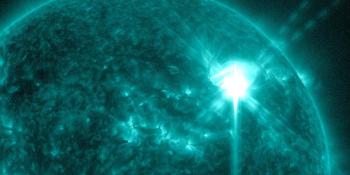Viendo archivo del jueves, 30 diciembre 2004
Informe actividad solar
Any mentioned solar flare in this report has a scaling factor applied by the Space Weather Prediction Center (SWPC). Because of the SWPC scaling factor, solar flares are reported as 42% smaller than for the science quality data. The scaling factor has been removed from our archived solar flare data to reflect the true physical units.
Informe de actividad Solar-Geofísica 2004 Dec 30 2200 UTCPreparado por NOAA © SWPC y procesado por SpaceWeatherLive.com
Informe conjunto USAF/NOAA de actividad Solar y Geofísica
SDF Número 365 Publicado el 2200Z a las 30 Dec 2004IA. Análisis de regiones solares activas y de actividad desde 29-2100Z hasta 30-2100Z Solar activity remained at moderate levels today.
Region 715 (N04E48) produced the largest flare of the period, an
M2/Sf x-ray event that occurred at 30/1047Z along with an associated
Tenflare (230 sfu) and a spectral Type II radio sweep that had an
estimated shock velocity of 653 km/s. LASCO imagery depicts a
resulting CME that appears to have a weak Earth directed component.
The strong delta structure remains intact and some growth in
penumbral coverage was observed during the period. Region 716
(S16E52) was numbered today.
IB. Pronóstico de la actividad solar
Solar activity is expected to be at
low to moderate levels. Region 715 remains magnetically complex
enough to produce isolated M-class flare activity.
IIA. Resumen de la actividad geofísica 29-2100Z a 30-2100Z
The geomagnetic field was at quiet to active levels today. The
elevated periods are most likely due to a waning high speed coronal
hole stream. The greater than 2 MeV electron flux at geosynchronous
orbit reached high levels again today.
IIB. Pronóstico de la actividad geofísica
The geomagnetic field is
expected to be at predominantly quiet to unsettled levels on 31 Dec
and 1 Jan. A glancing blow from the CME that resulted from M2/Sf
flare that occurred today could produce periods of active to minor
storm conditions beginning on 2 Jan.
III. Probabilidades del evento 31 Dec a 02 Jan
| Clase M | 60% | 60% | 60% |
| Clase X | 10% | 10% | 10% |
| Protón | 05% | 05% | 05% |
| PCAF | green | ||
IV. Penticton 10.7cm flujo
Observado 30 Dec 100 Previsto 31 Dec-02 Jan 100/105/105 Media de 90 Días 30 Dec 105
V. Índices Geomagnéticos A
Observado Afr/Ap 29 Dec 016/018 Estimado Afr/Ap 30 Dec 011/015 Previsto Afr/Ap 31 Dec-02 Jan 008/010-008/012-015/020
VI. Probabilidades de Actividad Geomagnética 31 Dec a 02 Jan
| A. Latitudes Medias | |||
|---|---|---|---|
| Activo | 20% | 20% | 35% |
| Tormenta Menor | 01% | 01% | 15% |
| Tormenta Mayor-Severa | 01% | 01% | 05% |
| B. Latitudes Altas | |||
|---|---|---|---|
| Activo | 20% | 25% | 40% |
| Tormenta Menor | 05% | 10% | 20% |
| Tormenta Mayor-Severa | 01% | 05% | 10% |
< < Ir a la visión general diaria
Últimas noticias
Últimos mensajes del foro
AR3664 176[CME] AR 13664, X1.04, 2024-05-08 8Incoming Active Regions 239AR3663 248Sporadic E and Flare activity 22
Más temasApoye a SpaceWeatherLive.com!
Mucha gente viene a SpaceWeatherLive para seguir la actividad del Sol o previsión de aurora, pero con esta cantidad de tráfico se incrementan los costos del servidor. ¡Considere hacer una donación si disfruta de SpaceWeatherLive para que podamos mantener el sitio web en línea!

Hechos clima espacial
| Último evento clase X | 2024/05/08 | X1.0 |
| Último evento clase M | 2024/05/08 | M4.0 |
| Últimas tormentas geomagnéticas | 2024/05/06 | Kp5 (G1) |
| Días sin manchas | |
|---|---|
| Último día sin manchas | 2022/06/08 |
| Promedio de manchas solares mensuales | |
|---|---|
| abril 2024 | 136.5 +31.6 |
| Last 30 days | 161.2 +69.2 |


